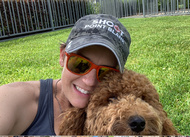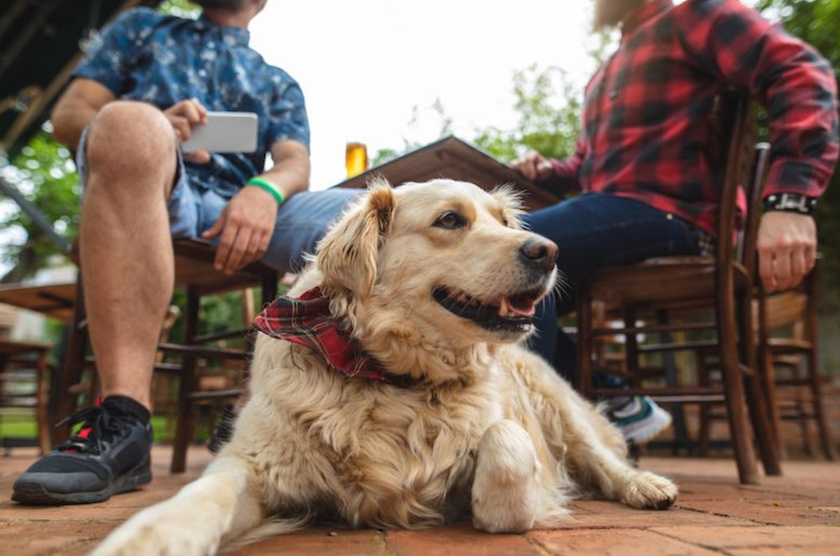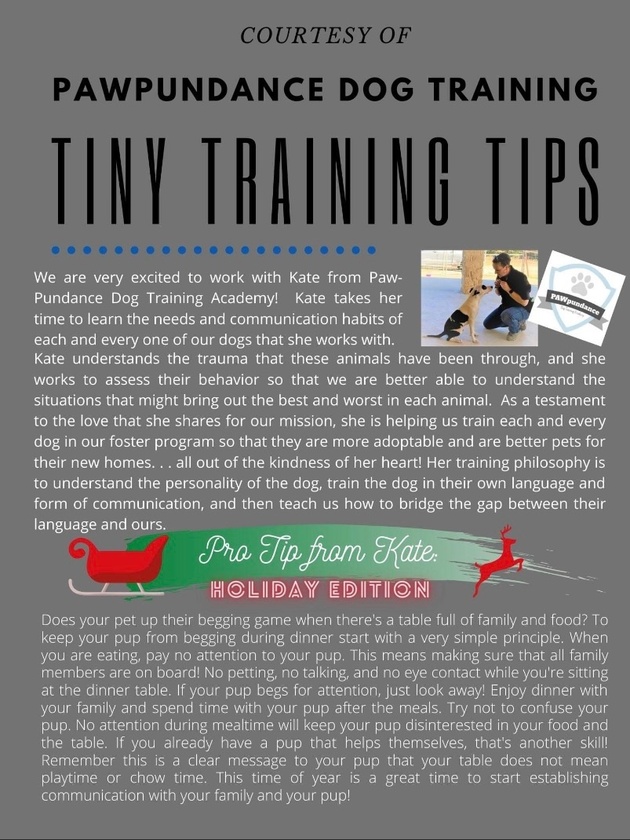
It’s ok! We’re here to help. We speak a little dog and can help translate for both of you. It’s probably just a miscommunication! And we are here to help get you both speaking the same language! Woof!
Connect with the PAWpundance training team and other members of the dog community to discuss better ways to communicate with your furry house guest.
**To get started USE code: TRIAL1month **
When working with Snowball, we had trouble "shaping" Snowball into a down. She is a 13 year old pup that never learned a good relationship with hoomans until just recently when she was adopted. She began learning to sit, which was difficult for her even to get her hip to move. She finally got that skill and learned to throw it, then began to throw it for EVERYTHING. So we began to ask her to pull her nose forward but she would not walk her feet forward. She just stood up when her nose came forward too far.
So we began a new tactic. We worked on catching her when she naturally went down. Forcing or manipulating her won't help her learn. And when we work with an older pup that doesn't "throw" behaviors naturally, we have to "catch" her doing the things we want. To do this we might have to help by controlling the environment.
There is a great story about a classroom exercise where the instructor was teaching how to use a clicker with the students (not dogs/animals). The instructor had one student (the subject/dog) leave the room. Another student was asked to be the trainer. The class agreed on a task. The subject (i.e. trainee) came back in the room and was given only clicks to guide them toward then end goal. So imagine the game "hot/cold" where you guide someone based on cues of temperature. Only this version is one sided and doesn't have too much increase in intensity... just the clicks. So the students were doing rounds and getting the hang of it until one student was the trainee and not very into his role. His hand remained in his pockets the whole time. This became a problem because the task require his hands. How can you tell him to take his hand out of his pockets with just a clicker? What the student/trainer did was very smart! She placed a chair in his path suddenly causing him to stumble and take his hands out of his pocket. When he did she clicked. This teaches us a very important principle when working with the pups, it's better to control the environment, than trying to control the puppy - in this way you are setting your pup up for a win.
When you control the conditions of the environment to work in such a way that you puppy is set up for a win, then your pup will be doing the action on their own. Then you can slowly relax the conditions of the environment... we will even challenge their environment with distractions and impulse control exercises... but all the while, the pup will be doing the action on their own - without force.
So to help Snowball, I left her alone on her cushion (that she naturally lays down upon) and ignored her. I busied myself with other things. Then when she got bored and laid down... click and reward. We set up the environment, she was placed on her cushion after a good walk - knowing she would be ready to lay down. It was all a well timed matter of capturing her laying down. After we caught her doing it, we did a big happy reward - Jackpot Treats. I gave her the snuggles that she loves. She's a small dog so I picked her up and snuggled her so she was standing and this reset her. Then we went back to minding our own business... She laid down again and whoohoo!! A few iterations later and she was laying down right after a set her back down. So we were ready to see if she would throw the "down".
I showed her a treat. But since "luring" is the most fragile of the positive-based styles, then put it in my fist and held it on my chest. I did not have it like the carrot drawing her constantly forward. She sat watching me, pondering me for sometime. I tapped the pillow with the gesture that we use for down and I repeated the cue that we had said... but I am careful not to use either of these in excess as it will dilute their meaning to just keep repeating them with no response. So I gave her the time to work out the puzzle in her head. When she gave signs of frustration, (yawning, licking, looking way, etc,) I was careful to keep coaching her and rewarding her for trying. Ordinarily, I don't use the phrase "good girl/boy" unless the pup has done something rewarding - it's similar to a clicker. It becomes a meaningless phrase if it's constantly used for meaningless actions. But in her case, just trying - She's 13 years old and come from an abusive situation. The gal that took her in was fostering senior dog and this girl hit the lotto. She is well cared for now - most senior pups wouldn't have hired a trainer to do this kind of work, but for whatever time she has left... this really helps her make the most of it. And this training is best suited to a situation like hers. We can use more precision to make sure we use the correct method. We want to teach her new skill while also build confidence and give her some behavioral structure she didn't have before. She's going to be stronger in every way after this!! But the key is to acknowledge how much of it is a dialog. I am asking her to go down, but I'm very much watching to see how she responds.
When she finally throws the behavior and starts walking her paws forward, we cheer!! We have an older pup - who previously knew of nothing but barks to get attention. Then she learned that she could sit and get really positive attention and treats and this was the second thing in her arsenal.
Currently she can throw a sit and down but hand signals along or by verbal signals. She can also walk loose leash, stay and come. She passed her first evaluation with flying colors and has her PAW5 certification. She's now working on her distance cues, impulse control cues and pressing on towards her final evaluation. She's come SOOOOO far!!
Way to Go!! Snowball!! More updates to come. Stay posted to her story!
Welcome to PAWpundance Dog Training Academy on Locals.com!
We’re thrilled that you’ve joined our community! PAWpundance is a place for positive, dog-loving people to come together, share experiences, and help each other grow. Locals offers an “ad-free experience,” so even a small contribution helps support our tech and keeps our community thriving.
We want to see your furbabies!
We’re here to assist with any questions you may have about training, behavior, and more. At PAWpundance, we believe in blending knowledge with a bit of fun—expect plenty of paws, puns, and maybe even a dance or two! Together, let’s enjoy some laughs and build stronger relationships with our pups.
Our Philosophy:
We’ve invited another species to live in our homes, and our dogs are much more than accessories; they’re our guests. They don’t speak our language, and like in the movie E.T., we don’t want to be the intimidating figures trying to coerce a scared, confused being. Instead, we want to be like ...
Eye Contact, Eye Contact, Eye Contact!
Reward every glance. Start by reinforcing brief glances, then encourage your pup to hold your gaze a bit longer. Gradually phase out your part of the eye contact—your pup will learn to watch you and adapt to your movements naturally. This approach helps them learn to walk with you without relying on leash cues.
Remember, the leash is purely for safety—not for communication.
Take a look at this video with Meghan and Buckee. Buckee is watching Meghan closely, and she rewards him by making eye contact, smiling, and offering treats. Meghan also looks forward occasionally, teaching Buckee to walk with her in sync.
Notice that Buckee is a reactive pup, so the leash is essential for safety, especially if he responds to something unexpectedly. However, it’s only used for physical control when necessary. When Buckee refocuses, Meghan reestablishes instructional control, and they continue their walk together. She does a fantastic job of engaging with him! In ...
Loose-Leash Walking Tip:
Where you reward makes a big difference! Try using the hand on the same side as your dog when giving treats or praise.
When you reach across your body to reward with the opposite hand, it draws your dog’s nose in front of you, encouraging them to move ahead and potentially start pulling.
In the video of Meghan and Domino, Meghan holds the leash with her left hand while Domino walks on her right. She rewards him by petting and giving treats with her right hand. This keeps Domino walking by her side on a loose leash, rather than in front, pulling her along.
Next time you’re out walking with your pup, try rewarding with the hand on the same side as your dog.
https://twitter.com/wholedogjournal/status/1295508215740932098?s=21
How to teach you pup to be a good dining companion! What a great skill!

https://twitter.com/wholedogjournal/status/1292609106637987840?s=21
This is about counter-surfers, but I love the description of trying to shame dogs. This author, Pat Miller helped me understand this concept in her book the Power of Positive Dog Training.
If you’re still on Twitter, the Whole Dog Journal is a great group to follow. Lots of fantastic info!













